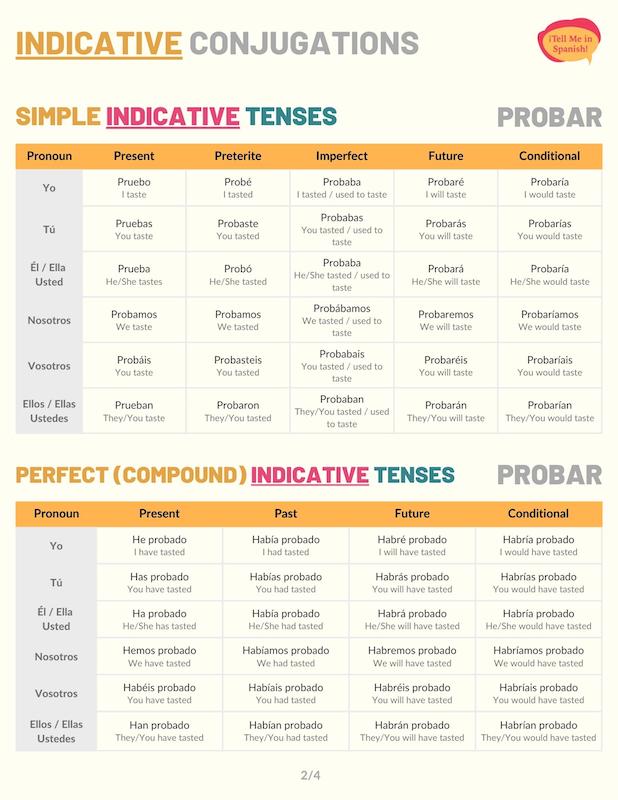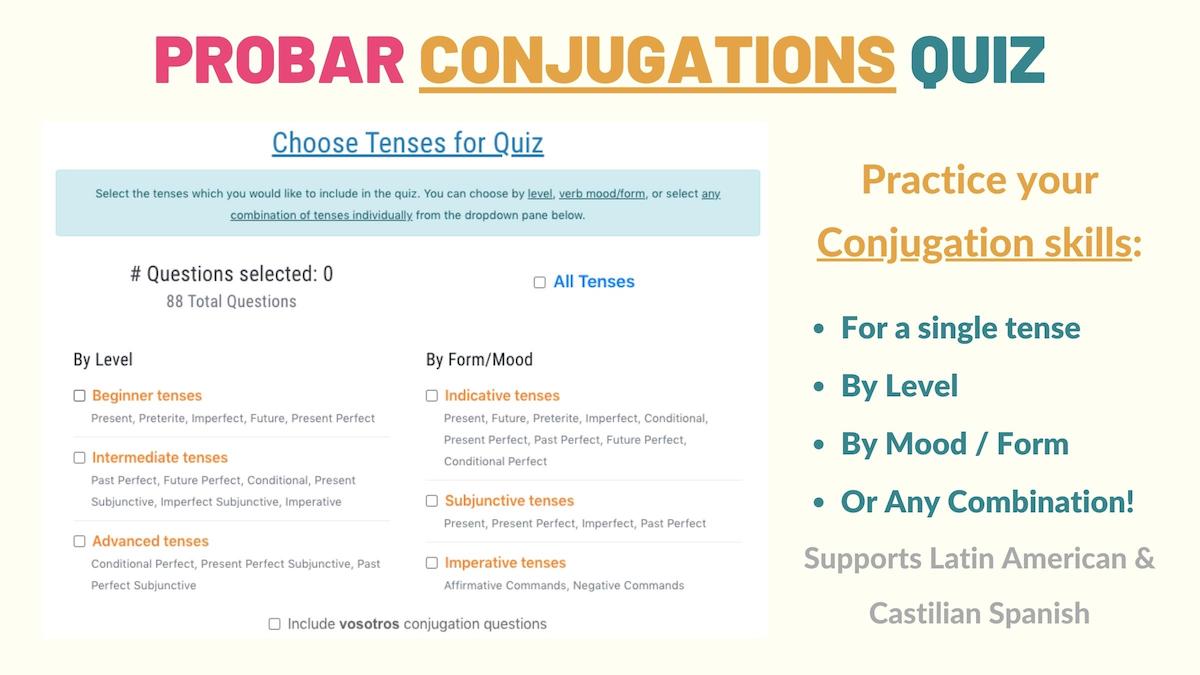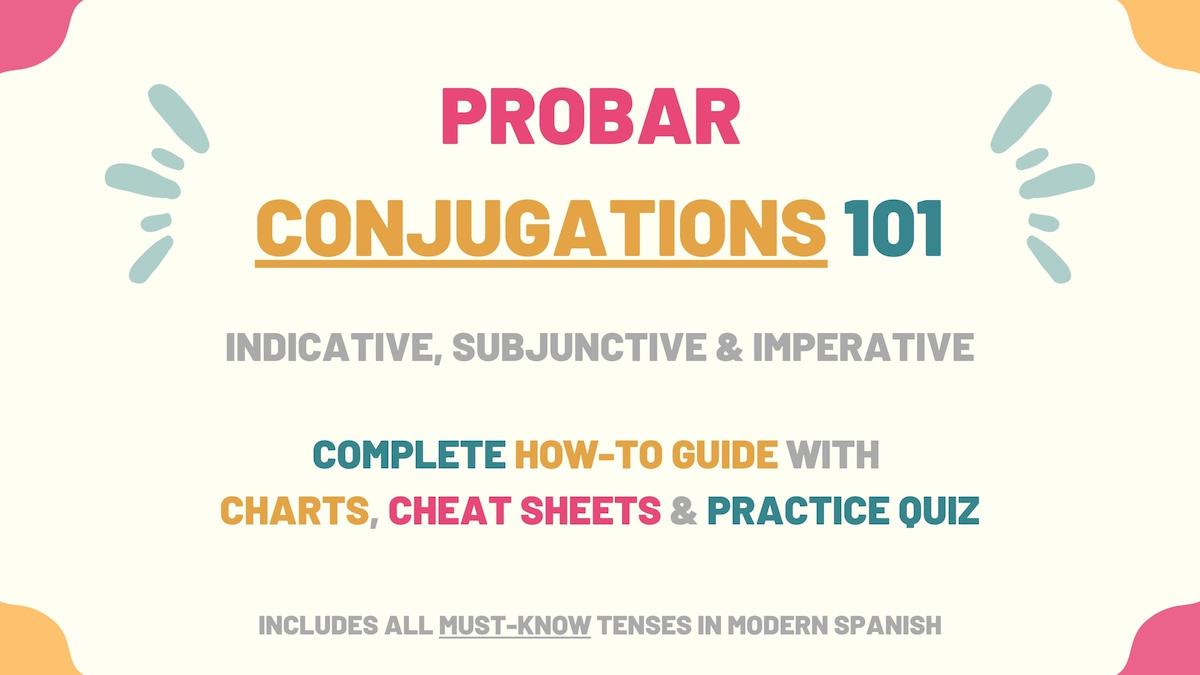Probar is an O to UE stem-changing verb. Given that it’s key for your conversations and it can also help you practice this spelling change, in this guide, we’ll learn the probar conjugation patterns you need to know to learn Spanish. Here is a summary of what we’ll go over:
- Probar Overview
- Indicative Tenses of Probar Conjugations
- Subjunctive Tenses of Probar Conjugations
- Imperative (Commands) of Probar Conjugations
- Uses & Examples
- Download Probar Conjugation Tables & Uses Cheat sheets
- Probar Conjugation Practice Quiz
Overview of Probar
| Verb Characteristic | Property |
|---|---|
| Verb Type | -AR |
| Irregular | No |
| Infinitive | Probar |
| Gerund (Present Participle) Form | Probando |
| Past Participle Form | Probado |
| Synonyms | Tratar, gustar, demostrar. |
Stem Changes: O to UE
- Present: prueb for all subject pronouns except ‘nosotros’ and ‘vosotros’.
- Present subjunctive: prueb for all subject pronouns except ‘nosotros’ and ‘vosotros’.
- Affirmative imperative: prueb for all subject pronouns except ‘vosotros’.
- Negative imperative: prueb for all subject pronouns except ‘vosotros’.
The verb probar in Spanish means ‘to taste’, ‘to try’, ‘to try on’, among other applications. The probar conjugation charts below only include one translation to keep the tables as organized as possible. You can learn more about the meanings of ‘probar’ in the section Uses & Meanings.
Indicative Conjugations of Probar
Present tense
Probar conjugations in the present tense have an O to UE stem change that doesn’t apply to ‘nosotros’ or ‘vosotros’. In the present indicative tense, this verb expresses that someone tastes something or is trying on some clothing.
For example: ¿Por qué no se prueban estas camisas?
| Person | Conjugation | Translation |
|---|---|---|
| Yo | Pruebo | I taste |
| Tú | Pruebas | You taste |
| Él / Ella Usted | Prueba | He/She tastes You (formal) taste |
| Nosotros | Probamos | We taste |
| Vosotros | Probáis | You taste |
| Ellos / Ellas Ustedes | Prueban | They taste You (plural) taste |
Preterite tense
In the past preterite tense, this verb is regular. Use probar preterite conjugations to convey that someone tasted or tried something at a specific moment in the past. For instance: ¿Ya probaron las galletas?
| Person | Conjugation | Translation |
|---|---|---|
| Yo | Probé | I tasted |
| Tú | Probaste | You tasted |
| Él / Ella Usted | Probó | He/She tasted You (formal) tasted |
| Nosotros | Probamos | We tasted |
| Vosotros | Probasteis | You tasted |
| Ellos / Ellas Ustedes | Probaron | They tasted You (plural) tasted |
Imperfect tense
When conjugated to the past imperfect in Spanish, probar allows you to talk about the things people tasted, tested, or tried for an extended period of time in the past. For example: Mi mamá siempre probaba todo antes de comprarlo.
| Person | Conjugation | Translation |
|---|---|---|
| Yo | Probaba | I tasted I used to taste |
| Tú | Probabas | You tasted You used to taste |
| Él / Ella Usted | Probaba | He/She tasted He/She used to taste You (formal) tasted You (formal) used to taste |
| Nosotros | Probábamos | We tasted We used to taste |
| Vosotros | Probabais | You tasted You used to taste |
| Ellos / Ellas Ustedes | Probaban | They tasted They used to taste You (plural) tasted You (plural) used to taste |
Near future
To form the immediate future in Spanish, use the formula ir (present tense) + a + probar. When conjugated to the near future, this verb conveys that someone is planning to try or taste something soon in the future. For example: ¿No vas a probar la sopa que hice?
| Person | Conjugation | Translation |
|---|---|---|
| Yo | Voy a probar | I’m going to taste |
| Tú | Vas a probar | You’re going to taste |
| Él / Ella Usted | Va a probar | He/She is going to taste You (formal) are going to taste |
| Nosotros | Vamos a probar | We’re going to taste |
| Vosotros | Vais a probar | You’re going to taste |
| Ellos / Ellas Ustedes | Van a probar | They’re going to taste You (plural) are going to taste |
Future simple tense
The Spanish future simple tense of this verb allows you to say that someone will taste or try something on at some point in the future. For instance: Probaremos todo lo que cocines.
| Person | Conjugation | Translation |
|---|---|---|
| Yo | Probaré | I will taste |
| Tú | Probarás | You will taste |
| Él / Ella Usted | Probará | He/She will taste You (formal) will taste |
| Nosotros | Probaremos | We will taste |
| Vosotros | Probaréis | You (formal) will taste |
| Ellos / Ellas Ustedes | Probarán | They will taste You (plural) will taste |
Conditional tense
Conjugate probar to the conditional tense in Spanish to communicate that someone would taste or try something. If applicable to your sentences, you can include conditions that need to be met. Here is a sentence: Yo nunca probaría esos platillos.
| Person | Conjugation | Translation |
|---|---|---|
| Yo | Probaría | I would taste |
| Tú | Probarías | You would taste |
| Él / Ella Usted | Probaría | He/She would taste You (formal) would taste |
| Nosotros | Probaríamos | We would taste |
| Vosotros | Probaríais | You would taste |
| Ellos / Ellas Ustedes | Probarían | They would taste You (plural) would taste |
Present perfect tense
With the Spanish present perfect tense, probar expresses that someone has or hasn’t tasted something. To build this tense, you must use the formula haber in the present tense + probado (past participle). For example: ¿Han probado el helado vegano?
| Person | Conjugation | Translation |
|---|---|---|
| Yo | He probado | I have tasted |
| Tú | Has probado | You have tasted |
| Él / Ella Usted | Ha probado | He/She has tasted You (formal) have tasted |
| Nosotros | Hemos probado | We have tasted |
| Vosotros | Habéis probado | You have tasted |
| Ellos / Ellas Ustedes | Han probado | They have tasted You (plural) have tasted |
Past perfect
When conjugated to the past perfect indicative tense, this verb conveys that someone had or hadn’t tried something before another past action or moment. For instance: Nunca había probado el vino tinto.
As shown in the probar conjugation chart below, this tense is formed with haber (imperfect form) + past participle form of ‘probar’.
| Person | Conjugation | Translation |
|---|---|---|
| Yo | Había probado | I had tasted |
| Tú | Habías probado | You had tasted |
| Él / Ella Usted | Había probado | He/She had tasted You (formal) had tasted |
| Nosotros | Habíamos probado | We had tasted |
| Vosotros | Habíais probado | You had tasted |
| Ellos / Ellas Ustedes | Habían probado | They had tasted You (plural) had tasted |
Future perfect
Conjugate this verb to the Spanish future perfect to explain that someone will have tasted or tried something on by or before a certain moment in the future. You can also use these forms to talk about what someone might have tasted.
For instance: en unas horas, habrán probado el pastel más rico del mundo.
| Person | Conjugation | Translation |
|---|---|---|
| Yo | Habré probado | I will have tasted |
| Tú | Habrás probado | You will have tasted |
| Él / Ella Usted | Habrá probado | He/She will have tasted You (formal) will have tasted |
| Nosotros | Habremos probado | We will have tasted |
| Vosotros | Habréis probado | You will have tasted |
| Ellos / Ellas Ustedes | Habrán probado | They will have tasted You (plural) will have tasted |
Conditional perfect
In the conditional perfect tense, probar conveys that someone would have tasted or tried something as long as a past condition had taken place. For instance: Si no hubieras insistido, jamás lo habría probado.
| Person | Conjugation | Translation |
|---|---|---|
| Yo | Habría probado | I would have tasted |
| Tú | Habrías probado | You would have tasted |
| Él / Ella Usted | Habría probado | He/She would have tasted You (formal) would have tasted |
| Nosotros | Habríamos probado | We would have tasted |
| Vosotros | Habríais probado | You would have tasted |
| Ellos / Ellas Ustedes | Habrían probado | They would have tasted You (plural) would have tasted |
Progressive tenses
Use the conjugations of estar + probando (gerund) to form progressive tenses in Spanish. These probar conjugations are used to express that someone is tasting or trying something at the moment of speaking or when a past action took place. For example: A las 9, ellos todavía estaban probando la computadora nueva.
| Progressive Tense | Formula | Translation Example |
|---|---|---|
| Present | Estar (present) + probando | I am tasting |
| Preterite | Estar (preterite) + probando | You were tasting |
| Imperfect | Estar (imperfect) + probando | He was tasting |
| Future | Estar (future) + probando | We will be tasting |
| Conditional | Estar (conditional) + probando | They would be tasting |
Probar Subjunctive Conjugations
The Spanish subjunctive mood is used to discuss wishes, hopes, demands, recommendations, expectations, doubts, or hypothetical situations. In the sections below, you’ll find the key probar conjugation charts for the subjunctive tenses.
Present subjunctive
The present subjunctive of probar has an O to UE stem change for all subjects except ‘nosotros’ and ‘vosotros’. Conjugate this verb to the present subjunctive when demanding, suggesting, or wishing that someone tries something. For example: Te sugiero que pruebes este postre.
| Person | Conjugation | Translation |
|---|---|---|
| Yo | Pruebe | I taste |
| Tú | Pruebes | You taste |
| Él / Ella Usted | Pruebe | He/She tastes You (formal) taste |
| Nosotros | Probemos | We taste |
| Vosotros | Probéis | You taste |
| Ellos / Ellas Ustedes | Prueben | They taste You (plural) taste |
Present perfect subjunctive
The present perfect subjunctive of probar is formed with haber in the present subjunctive + past participle form (probado). Use these forms to wonder, express doubt, or wish that someone has already tasted or tried something. For instance: Espero que hayan probado el helado que hice.
| Person | Conjugation | Translation |
|---|---|---|
| Yo | Haya probado | I have tasted |
| Tú | Hayas probado | You have tasted |
| Él / Ella Usted | Haya probado | He/She has tasted You (formal) have tasted |
| Nosotros | Hayamos probado | We have tasted |
| Vosotros | Hayáis probado | You have tasted |
| Ellos / Ellas Ustedes | Hayan probado | They have tasted You (plural) have tasted |
Imperfect subjunctive
Use the Spanish imperfect subjunctive to refer to past suggestions, requests, and wishes someone had about a person tasting or trying something. Me gustaría que probaras esta gelatina.
There are two conjugation models for the imperfect subjunctive tense in Castilian and Latin American Spanish:
Latin American Spanish version
| Person | Conjugation | Translation |
|---|---|---|
| Yo | Probara | I tasted |
| Tú | Probaras | You tasted |
| Él / Ella Usted | Probara | He/She tasted You (formal) tasted |
| Nosotros | Probáramos | We tasted |
| Ellos / Ellas Ustedes | Probaran | They tasted You (plural) tasted |
Note: In Latin American Spanish, the pronoun vosotros is never used. As a result, the probar conjugation chart above doesn’t include this pronoun and its conjugation.
Castilian Spanish version
| Person | Conjugation | Translation |
|---|---|---|
| Yo | Probase | I tasted |
| Tú | Probases | You tasted |
| Él / Ella Usted | Probase | He/She tasted You (formal) tasted |
| Nosotros | Probásemos | We tasted |
| Vosotros | Probaseis | You tasted |
| Ellos / Ellas Ustedes | Probasen | They tasted You (plural) tasted |
Past perfect subjunctive
In Spanish, we conjugate probar to the past perfect subjunctive to say that someone would have tasted something if a past circumstance had occurred. We also use these conjugations to express regret for tasting or not tasting something.
For example: ¡Lo hubieras probado, estaba buenísimo!
| Person | Conjugation | Translation |
|---|---|---|
| Yo | Hubiera probado | I had tasted |
| Tú | Hubieras probado | You had tasted |
| Él / Ella Usted | Hubiera probado | He/She had tasted You (formal) had tasted |
| Nosotros | Hubiéramos probado | We had tasted |
| Vosotros | Hubierais probado | You had tasted |
| Ellos / Ellas Ustedes | Hubieran probado | They had tasted You (plural) had tasted |
Probar Imperative Conjugations
Commands in Spanish are used to order people to do or not do an activity.
Affirmative commands
Except for ‘vosotros’, the affirmative imperative of probar has an O to UE change. Use these affirmative commands to compel someone to taste or try something. Pruébate esta camisa.
| Person | Conjugation | Translation |
|---|---|---|
| Tú | Prueba | Taste |
| Usted | Pruebe | Taste |
| Vosotros | Probad | Taste |
| Ustedes | Prueben | Taste |
Negative commands
In the Spanish negative imperative, probar is an O to UE stem-changing verb. These commands are used to order or instruct people not to taste or try something. For example: No prueben la sopa, está malísima.
| Person | Conjugation | Translation |
|---|---|---|
| Tú | No pruebes | Don’t taste |
| Usted | No pruebe | Don’t taste |
| Vosotros | No probéis | Don’t taste |
| Ustedes | No prueben | Don’t taste |
Meanings of Probar & Examples
Since you’ve just learned how to conjugate probar in Spanish, in this section, we’ll go over some of the most common uses of this verb. Probar means to:
- Taste or try (not for activities)
- Prove something
- Try on (needs reflexive pronouns)
- Check or test
(Object pronoun) + [probar conjugated] + [determiner] + [noun]
Pruébate estas camisas.
Try these shirts on.
Voy a probar que te equivocas.
I am going to prove that you’re wrong.
Compré una computadora, pero no la he probado.
I bought a computer, but I haven’t tried it.
Take Note: Indirect, direct, and reflexive pronouns are called object pronouns. With probar, we use Spanish reflexive pronouns to say that a person is trying something on. On the other hand, if we’re saying that someone tasted food or tried a device, we can use direct object pronouns.
Download Probar Conjugation Tables & Uses Cheat sheets

Probar has stem changes in a few tenses, so those conjugations can take some time to learn. You can download a PDF copy of this verb’s cheat sheets which include all the probar conjugation charts as well as its definitions, uses & examples.
Practice Quiz: Probar Conjugation

Now that you know how to conjugate probar in Spanish, you can practice this verb’s different forms, including its stem changes by taking the probar conjugation practice quiz.



